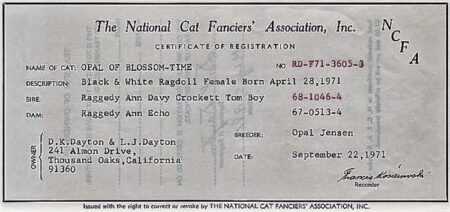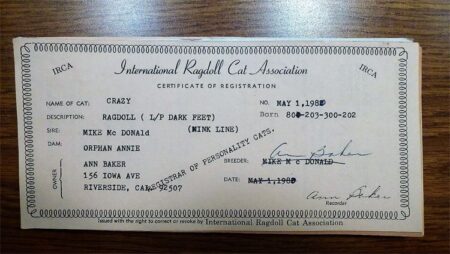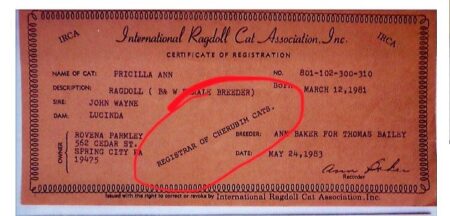
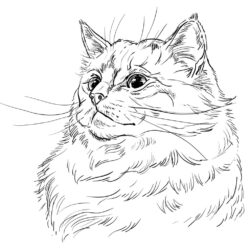
Dear Members of the Ragdoll Breed Group:
Greetings! I am Christine Lupo, and I am officially submitting my candidate statement for the 2023 TICA Ragdoll Breed Committee. I live in the USA, residing in the middle of Long Island, NY. I have owned and have shown my Ragdolls for fifteen years. I have done this in the capacity of exhibitor and as a show manager. Exhibiting and breeding Ragdolls is my passion, as I do enjoy advising and educating kitten clients, breeders, exhibitors, and spectators about the exquisite Ragdoll breed. I am an ambassador for the breed every day. My cattery has been awarded The International Cat Association’s Outstanding Cattery Certification in 2022 and 2023. Through careful and selective breeding, NYDIVINEDOLLS Cattery is the home to numerous TICA Supreme and Quadruple Grand Champions, as well as up and coming stars.
Please allow me to share my history with the Ragdoll breed with you. Knowing my commitment to the Ragdoll breed will allow you to understand why I feel I would be the best candidate for this position. I attended my first show with my first two Ragdoll kittens in 2008. One was a pointed Ragdoll, and the other was a mink Ragdoll. It has been an ongoing learning experience ever since. At that first show, I met my first mentor who guided me in officially establishing my cattery, NYDIVINEDOLLS, in TICA, in 2010. This individual also educated me about the importance of ethical breeding, being proactive by ensuring that each cat was genetically sound and healthy through testing, as well as practicing and adhering to the protocols of showing in this organization. Through showing, I met two Ragdoll breeders who worked with Ann Baker and shared the history of the breed with me. One bred solid, mink, and pointed Ragdolls, the other bred only the pointed. The latter advised me to spay the mink, which I declined to do; however, years later upon retiring, she honored me by entrusting three of her pointed Ragdolls to me to continue her lines. Three other ladies, Ragdoll breeders and one a Singapura breeder, taught me the crucial importance and value of reading, understanding, checking, and maintaining accurate pedigrees. This was especially important for those Ragdolls that come from pure lines, whether they are mink, solid, or pointed. It is for these reasons that heartiness, temperament, maintaining clean pedigrees, and conformation to breed standards, in that order, became my priorities and mission in regard to breeding and showing Ragdolls. Learning and improving one’s lines is an ongoing and never ending project.
Should I be honored and granted the position of a Ragdoll Breed Committee member, I will continue to advocate for all purebred TICA registered Ragdolls. I will continue to work toward getting mink, sepia, and solid Ragdolls accepted for championship as Ragdolls, and do so through a proposal to amend the current standard (TICA By Laws, Article Seven, 17.4). If approved by a majority of the newly elected Ragdoll Breed Committee and Genetics & Rules Committee, I will ensure all members of the Ragdoll Breed Section are made aware of the proposal and are reached to voice their preferences via polling. This goal can be achieved through collaborative discussion with a Ragdoll Breed Committee that is truly representative of all voting members of the Ragdoll Breed Section. This will be beneficial for the Ragdoll gene pool, good for TICA, and will serve to enlighten the public about all Ragdolls. In addition to this, I will work tirelessly to ensure that educational seminars for judges, exhibitors, and spectators will be constant. It is for these reasons that I request that you vote for me. Thank you for your consideration, as well as your valuable time.
Warmest regards,
Christine Lupo
The International Ragdoll Cat ALLIANCE
Ragdoll Breed Group Rational
Christine Lupo, Amanda Jimmink, Elizabeth Boatwright
“People talk about the middle of the road as though it were unacceptable. Actually, all human problems, excepting morals, come into the gray areas. Things are not all black and white. There have to be compromises. The middle of the road is all of the usable surface. The extremes, right and left, are in the gutters.” –President Dwight D. Eisenhower
Breeders of blue-eyed pointed (BEP) Ragdolls and breeders of mink, sepia, and solid Ragdolls are working together to find a compromise in the advancement of the “New Traits” Ragdolls to the Championship class. The current Ragdoll standard only allows for BEP cats. The mink, sepia, and solids cannot show in the championship class. The authors of this proposal, under the governing regulations 31.4 and 33.9, respectively, in the TICA Registration Rules & Related Standing Rules, seek to establish a Ragdoll breed group to create a separate breed, namely Cherubim, for mink, sepia, and solid Ragdolls so that they may compete in the Championship class.
Ann Baker was the originator of the Ragdoll breed. While the BEP Ragdoll was the first focus of Ann Baker, she also developed other categories & breeding lines. These lines included all colors and patterns. All breeding lines developed by Ann Baker printed the following phrase across their IRCA Ragdoll registrations: “Registrar of Cherubim Cats.” When certificates of registration were transferred from IRCA to the TICA Registry,
all cats in all colors were registered as Ragdolls in one grouping. As such, a breed group structure correctly reflects the Ragdoll/Cherubim relationship. The breed name Cherubim has been widely accepted by many Ragdoll breed section members, and we propose using Cherubim as the new breed name for the mink, sepia, and solid Ragdolls.
The TICA website states, “the strength of TICA lies in its members. Breeders, exhibitors, and cat lovers are invited to join TICA and participate in the most progressive registry in the world” (www.TICA.org). A total of 1088 members of the Ragdoll Breed Section joined TICA because they, too, believe it to be the most progressive registry in the world. The mink, solid, and sepia Ragdolls breeders trust this mantra and it is time for the mink, solid, and
sepia Ragdolls to advance to championship status. This will allow them to have a written standard they can breed to so they can show and preserve their lines. To date, thirty-three exhibitors have internationally shown their solid, mink, and sepia Ragdolls for the purpose of submitting the application for the advancement of “New Traits” to the Championship class and request TICA recognize their cats. The authors propose the creation of a breed group which will allow the separation and coexistence of pointed and mink, sepia, and solid. This concession will seek to have the solid, mink, and sepia adopt the name of “Cherubim.” These concessions are made to ensure ease of passing a breed section vote and to receive recognition in a Ragdoll Breed Group Standard, on the TICA website, in the show halls and breed seminars for the Ragdoll Breed Group. Given the history and the genetic evidence of the origins of all Ragdoll cats, it is reasonable to see that the current barrier to the exhibition hall is not aligned with TICA founding principles.
The authors believe this would create a sense of belonging for many and ultimately increase the number of exhibitors (and spectators) if the mink, solid, and sepia are accepted for show and the current TICA Ragdoll Breed Standard is amended to reflect a breed group. The growth in membership within the Ragdoll breed section from September 14, 2023 (951 members) to October 24, 2023 (1088 members) is substantial. That is 13% growth in approximately a one-month period. The authors surmise that much of this occurred as a result of discussions of a breed group and the notice of intent to apply for advancement to championship “New Traits” status published on October 17, 2023 in the TICA Trend. The authors believe that this is indicative of members who breed mink, solid, and sepia Ragdolls acting upon their excitement over the possibility of earning titles and learning within the show halls.
Representatives, breeders, and exhibitors of all viewpoints have collaborated to determine an equitable compromise. The solution, based upon our unofficial poll, that will pass with a majority breed section vote is the creation of a Ragdoll Breed Group to separate the BEP Ragdolls from the mink, sepia and solid Cherubims (72% voted yes to being open a breed group, dependent on name). This will allow the BEP offspring of mink, sepia, and solid cats to be registered and shown as Ragdolls while also allowing Championship Status for the Cherubim (mink, sepia, solid) cats themselves. This document proposes the necessary changes to the Ragdoll Standard to accomplish the creation of a Ragdoll Breed Group (RD/CH) and allow for the advancement of the mink, sepia, and solid Cherubim into Championship. A Ragdoll Breed Group is, in Eisenhower’s words, our “usable surface.”
SOURCES:
Baker, Ann. Ann Baker’s Autobiography: Cherubims Research. Published by Business and Consumer Advocate of the Animal World. 1985.
Pickering, Robin, Pollard, David, Wallace, Lorna. The Definitive Guide to Ragdolls. Pontefract, W. Yorkshire: Ragdoll World. 1995. First Edition.
TICA Registration Rules & Related Standing Rules. 19 January 2023. Version A. 28 October 2023. https://tica.org/resources/our-publications/rules-regulations/file/1146-registration-rules-version-a-19-jan-2023-4
UC Davis Veterinary Medicine, Veterinary Genetics Laboratory. Colorpoint Restriction. 28 October 2023. https://vgl.ucdavis.edu/test/colorpoint-restriction
Title – Ragdoll (RD) is changed to Ragdoll Breed Group (RD/CB)
Add line(s): The Ragdoll (RD) is a large semi-longhair, blue eyed pointed cat of moderate type. The Cherubim (CB) is a large semi-longhair, mink, sepia, or traditional colored cat of moderate type.
CATEGORY: RD – Pointed; CB – Mink, Sepia & Traditional.
DIVISIONS: RD – Solid Point Division; Tortie Point Division; Tabby Point
Division; Solid Point/white, Tortie Point/white, Tabby Point/white Divisions (mitted and bicolor patterns ONLY). CB – Solid Division; Tortie Division; Tabby Division; Solid & White, Tortie &white, Tabby & white Divisions (mitted and bicolor patterns ONLY).
COLORS:
RD: All pointed colors.
CB: All mink, sepia & traditional colors
Eyes: Large oval. Level set; moderately wide apart. Emphasis should be on correct shape, size and placement. Preference given to deeper tones in all colors.
RD – Blue, CB – Mink: Blue-Green to Green-Blue (Aqua); Sepia: Gold, Gold-Green (chartreuse) or Green Traditional: Bronze, Copper, Gold, Yellow, Green, or Hazel
COLOR/PATTERN:
SOLID POINT/SOLID DIVISION:
(RD) Pointed: Ears, mask, legs, feet and tail to be darker, well-defined color. Chest bib and chin areas may be somewhat lighter in color.
Even and lighter color on the body with minimal shading. Soft shadings of color are allowed. Definite contrast between body and point color. Allow for darker body color in older cats. Allow for undeveloped color in young cats.
(CB) Mink: Even, medium shade of body color, showing contrast to points. Allow for darker body color in older cats. Allow for undeveloped color in kittens and young cats. (CB) Sepia: Body color closer to that of extremities, showing slighter contrast to points. Allow for darker body color in older cats. Allow for undeveloped color in kittens and young cats. (CB) Traditional: Even solid color for solid-colored coats
GENERAL DESCRIPTION:
The ideal cat of this breed group is a large semi-longhaired cat with a sweet personality. They are a well-balanced cat of moderate type, with no extremes, and no one feature overpowering another. The breed grows large and heavy but is slow to mature and may not reach full weight and size for four years. Full color is not reached until 3 years old. They are muscular cats with little fat except on the lower abdomen fatty pad.
WITHHOLD ALL AWARDS (WW)
General: Doming. RD- Any eye color other than blue. CB; Mink – Any eye color other than blue-green to greenblue (aqua), Sepia; Any eye color other than: Gold, Gold-Green (chartreuse) or Green, Traditional; Any eye color other than Bronze, Copper, Gold, Yellow, Green, or Hazel.
UPDATE!!! Click on the document below!
TICA Ragdoll/Cherubim Breed Standard Effective May 1, 2025:
Hallelujah!!! The proposal for the TICA Advancement of New Traits as a Ragdoll/Cherubim Breed Group passed by a UNANIMOUS vote—that is absolutely fantastic, incredible, nothing short of spectacular and ground breaking! We would like to express our extreme gratitude to the TICA Board of Directors! The Ragdoll Breed Section is to be commended on their participation and input! I am still in shock, awe, and experiencing absolute euphoria! Congratulations to those who served as ambassadors for the solid, mink, and sepia Ragdolls (Cherubim) these many past years in “NT” and never gave up through the occasional stormy climate. Congratulations and hat tip to those who collaborated, supported, and pushed this initiative to pass—we are greatly appreciative for your partnership in this endeavor. I know that you also felt the sting of intermittent hailstorms. You are pioneers! We ARE a fabulous team! Elizabeth Boatwright, your contributions, grace, and honesty as a sounding board were invaluable. Amanda C. Jimmink, your guidance, leadership, and diplomacy, absolutely, was the glue that gently and logically coaxed all to openly communicate, embrace differences, and to overcome challenges. Now, comes the work of maintaining the momentum through documentation…To those who are currently on the Ragdoll Breed Committee and supported our proposal, you certainly will have my vote in the next cycle, and hopefully, we can elect a candidate or two who actually breed the Cherubim onto that committee. We need to get together to celebrate this mutual victory!!!🍾 🥂
What's next, you ask?
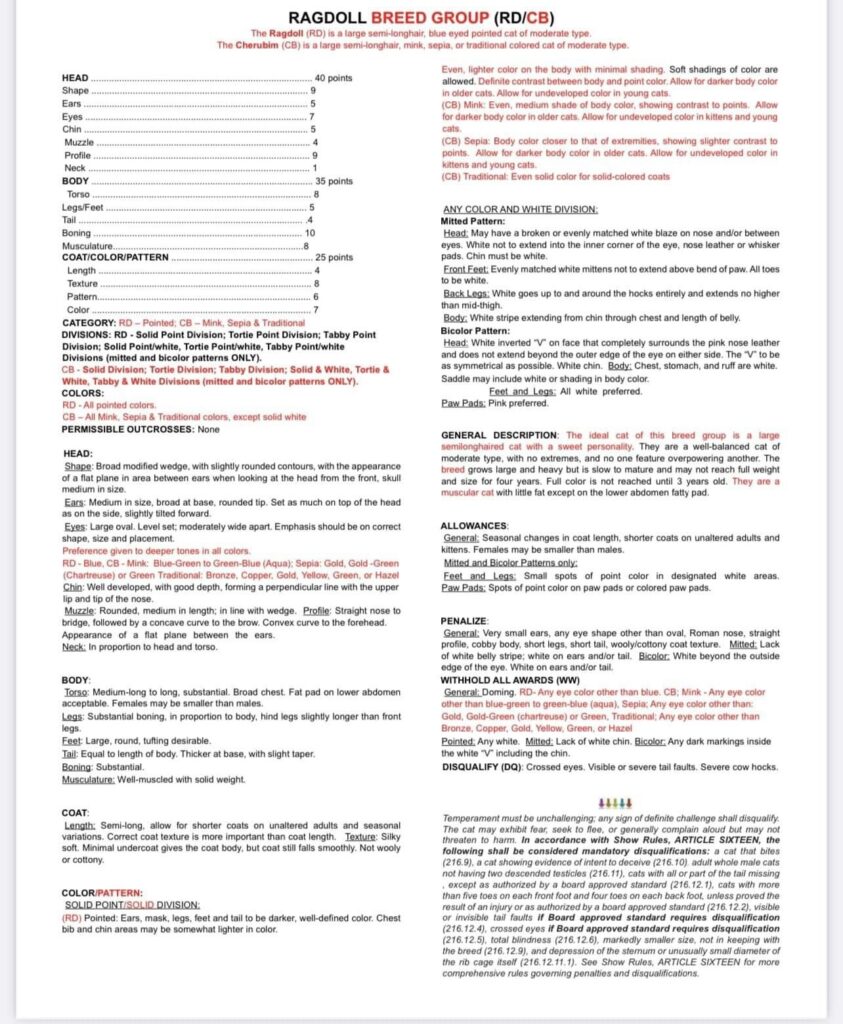
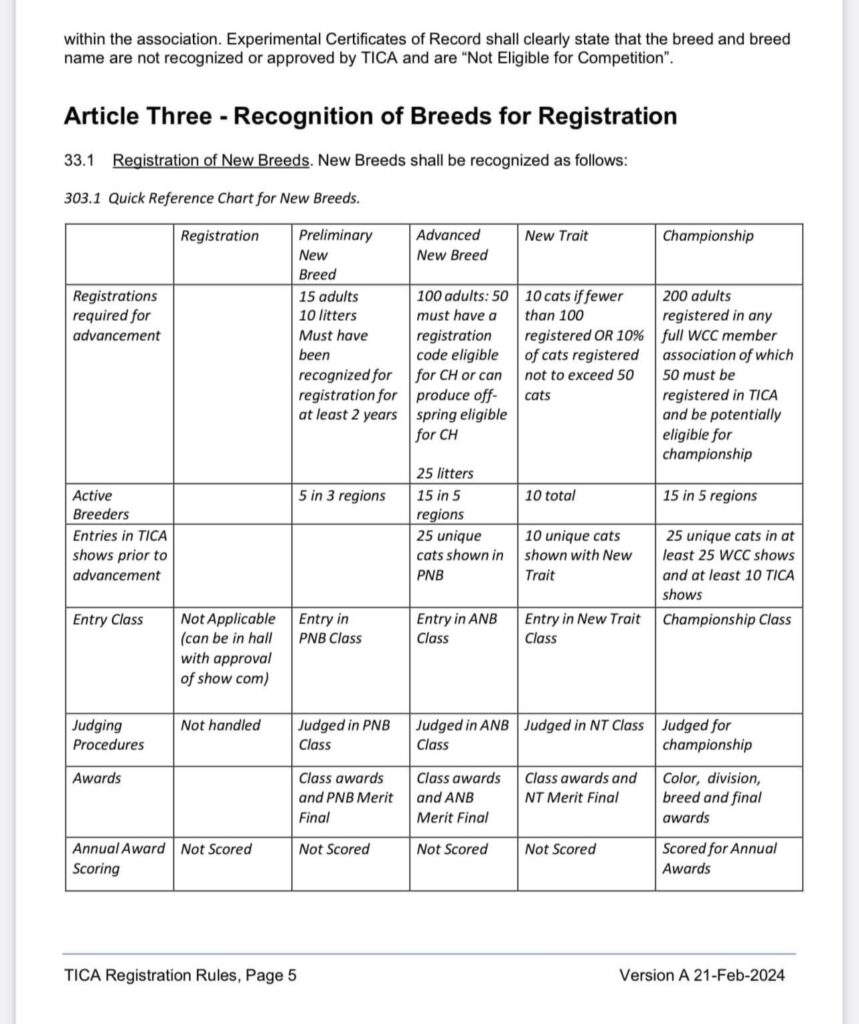
.
CHECK YOUR PEDIGREES AND FOUNDATION for MINK Ragdoll, Mike McDonald.
Click to enlarge above photos
The only difference between the Ragdoll and the Solid, Mink, and Sepia Ragdolls is caused by the C-locus (which is responsible for the self-color, pointed, and Sepia gene) . All of the other characteristics are the same. The Ragdoll Breed Committee should represent ALL Ragdolls in the standard and simply amend it to represent the coloration of all Ragdolls that are, and have been registered SBT Ragdolls in TICA.
My Original proposed changes in regard to a Ragdoll Breed Group:
Pointed: (RD), Mink Ragdolls: (RD-M); Sepia Ragdolls (RD-Sa); Solid Ragdolls (RD-Sd).
RD-Sa: Sepia
RD-M: Mink Solid, Mink Tortie, Mink Tabby, Mink Solid and White, Mink Tortie and White, Mink Tabby and White.(Solid, mitted and bicolor pattern ONLY).
RD-Sa: Sepia Solid, Sepia Tortie, Sepia Tabby, Sepia Solid and White, Sepia Tortie and White, Sepia Taby and White. (Solid, mitted and bicolor pattern ONLY).
RD-Sd: Traditional Solid, Traditional Tortie, Traditional Tabby, Traditional Solid and White, Traditional Tortie and White, Traditional Tabby and White. (Solid, mitted and bicolor pattern ONLY).
COLORS:
RD: seal point
blue point
chocolate point
cinnamon point
lilac point
fawn point
red point
cream point
seal tortie point
blue tortie point
chocolate tortie pt
cinnamon tortie pt
lilac tortie point
fawn tortie point
RD-Sd: black
blue
chocolate
cinnamon
lilac
fawn
red
cream
black tortie
blue tortie
chocolate tortie
cinnamon tortie
lilac tortie
fawn tortie
white
RD-M: seal mink
blue mink
chocolate mink
cinnamon mink
lilac mink
fawn mink
red mink
cream mink
seal mink tortie
blue mink tortie
chocolate mink tortie
cinnamon mink tortie
lilac mink tortie
fawn mink tortie
RD-Sa: seal sepia
blue sepia
chocolate sepia
cinnamon sepia
lilac sepia
fawn sepia
red sepia
cream sepia
seal sepia (sable) tortie
blue sepia tortie
chocolate sepia tortie
cinnamon sepia tortie
lilac sepia tortie
fawn sepia tortie
PERMISSIBLE OUTCROSSES:
NONE.
HEAD (ALL):
Shape (RD): Broad modified wedge, with slightly rounded contours, slightly rounded forehead (not domed), appearance of flat plane in area between ears, skull medium in size.
Ears (ALL):
Medium in size, broad at base, rounded tip. Set as much on top of the head as on the side, slightly tilted forward.
Eyes:
Large, oval, moderately wide-set, outer aperture to fall in line with base of ear.
RD: Pointed colors have blue to violet eyes, with deeper color preferred.
RD-M: Mink colors typically have blue-green to green-blue (aqua) eyes, with preference given to
deeper, richer, more vibrant tones.
RD-Sa: Sepia colors typically have gold or gold-green (chartreuse) eyes, with preference given to
deeper, richer, more vibrant tones.
RD -Sd: (Self-colored) Traditional colors typically have bronze, copper, gold, yellow, green, or hazel eyes. Preference
is to be given to deeper, richer, more vibrant tones.
Chin (ALL):
Well-developed. Straight from nose to bottom of chin.
Muzzle (ALL):
Rounded, medium in length; in line with wedge.
Profile (ALL):
Chin well-developed in line with nose. Straight nose to bridge followed by change of direction to gentle curve to brow. Appearance of flat plane between ears.
Neck (ALL):
In proportion to head and torso.
BODY (ALL):
Torso: Medium-long to long, substantial. Broad chest. Fat pad on lower abdomen acceptable. Females may be smaller than males.
Legs: Substantial boning, in proportion to body, hind legs slightly longer than front legs.
Feet: Large, round, tufting desirable.
Tail: Equal to length of body. Thicker at base, with slight taper.
Boning: Substantial.
Musculature: Well-muscled with Solid weight.
COAT (ALL):
Length: Semi-long, allow for shorter coats on unaltered adults and seasonal variations.
Texture: Silky soft, plush, similar to rabbit fur. Minimal undercoat gives the coat body,but coat still falls smoothly. Not woolly or cottony.
COLOR:
RD (Pointed): Even, lighter color on the body with minimal shading. Definite contrast between body and point color. Allow for darker body color in older cats. Allow for undeveloped color in young cats. Kittens are born almost white and develop color on the points while remaining pale and creamy colored on the body. Body color often darkens with age, but not to the extent of the corresponding minks. Body shading, if any, shouldbe in the tone of the point color. In the pointed category, darker spots may develop over pressure points such as the hips, especially in older cats. Points of injury or resulting from other causes of recent hair loss (e.g. on the breast area of recently nursing queens) may show similar color changes.
RD-M: The coat darkens with age: kittens are born much lighter than the corresponding sepias (almost white in some colors) then develop noticeably darker color at the points than on the body.
RD-Sa: Coat color is paler and warmer than the traditional equivalents due to the reduction in the amount of pigment in the melanin granules. The coat darkens with age and has slight intensification at the points which is most visible in kittens.
RD-Sd: Kittens are born with full color. Traditional coat colors do not dramatically change in intensity with age.
SOLID POINT DIVISION:
Points: Ears, mask, legs, feet and tail to be darker, well-defined color.
Body: Chest bib and chin areas may be somewhat lighter in color. Soft shadings of color are allowed.
ANY COLOR AND WHITE DIVISION:
Mitted Pattern:
Head: May have a broken or evenly matched, symmetrical white blaze on nose and/or between eyes. White not to extend into the inner corner of the eye, nose leather, or whisker pads. Chin must be white.
Front feet: Evenly matched white mittens not to extend above bend of paw. All toes to be white.
Back Legs: White goes up to and around the hocks entirely and extends no higher than mid-thigh.
Body: White stripe extending from chin through chest and length of belly.
Bicolor Pattern:
Head: White inverted “V” on face that completely surrounds the pink nose leather and does not extend
beyond the outer edge of the eye on either side. The “V” to be as symmetrical as possible. The shape should be an inverted “V.” White Chin.
RD-Sd: (Self-colored solid) As described in TICA Color Descriptions.
RD-M: (Mink) Body color in Minks a distinctly lighter shade of point color, showing definite contrast to points, but not as much as with the pointed Ragdoll. Even, lighter color on the body. Allow for darker body color in older cats. Allow for undeveloped color in young cats.
RD-Sa: (Sepia) Body color in Sepias closer to that of extremities, showing slighter contrast to points.
Even, lighter color on the body. Allow for darker body color in older cats. Allow for undeveloped color in young cats.
WITHOUT WHITE DIVISION:
RD-Sd: (Self-colored)
The color is evenly across the whole cat. Lighter color on the collar allowed.
RD-M: (Mink)
Points: Ears, mask, legs, feet and tail to be darker, well-defined color.
Body: Chest bib and chin areas may be somewhat lighter in color. Shadings of color are allowed.
RD-Sa: (Sepia)
Points: Ears, mask, legs, feet and tail to be somewhat darker, well-defined color.
Body: Chest bib and chin areas may be somewhat lighter in color. Shadings of color are allowed.
ANY COLOR AND WHITE DIVISION:
Mitted Pattern:
Head: May have a broken or evenly matched, symmetrical white blaze on nose and/or between eyes. White not to extend into the inner corner of the eye, nose leather or whisker pads. Chin must be white.
Front feet: Evenly matched white mittens not to extend above bend of paw. All toes to be white.
Back Legs: White goes up to and around the hocks entirely and extends no higher than mid-thigh.
Body: White stripe extending from chin through chest and length of belly.
Bicolor Pattern:
Head: White inverted “V” on face that completely surrounds the pink nose leather and does not extend
beyond the outer edge of the eye on either side. The “V” to be as symmetrical as possible. White Chin.
Body: Chest, stomach and ruff are white. Saddle may be broken that may include spots of white.
RD-Sd: With the self-colored the saddle must have the body color.
RD-M and RD-Sa: With the Minks and Sepias shading in body color allowed.
Feet and Legs: All white preferred.
Paw Pads: Pink preferred, but mixture of color on paw pads acceptable because of two colors in pattern.
GENERAL DESCRIPTION:
RD: The Pointed Ragdoll is a semi-long haired, blue eyed pointed cat with a sweet personality. The Ragdoll grows large and heavy, but is slow to mature and may not reach full weight and size for four years. Full color is not reached until three years old. The Ragdoll is muscular with little fat except on the lower abdomen fatty pad.
RD-Sd; RD-M; RD-Sa: The Solid, Mink, and/or Sepia Ragdoll is a semi-long haired cat with a sweet personality, which grows large and heavy, but is slow to mature and may not reach full weight and size for four years.
RD-Sd: The self-colored have their full color at birth.
RD-M: The Mink is born with color but full color is not reached until three years old.
RD-Sa: The Sepia is born with color, darker than the Mink, but full color is also not reached until three years old. The Ragdoll is muscular with little fat except on the lower abdomen fatty pad.
ALLOWANCES:
Seasonal changes in coat length.
PENALIZE:
Mitted: Lack of white belly stripe; Hock spots.
Bicolor: White beyond the outside edge of the eye. Lack of inverted “V” such as a rectangle, “M”, heart shape, etc. Hock spots.
WITHHOLD ALL AWARDS (WW):
General: Short tail, tall triangular pointy ears, short legs; cobby body, round eyes, flat plane between eyes, doming of the head (concave curve to brow and convex curve to forehead); Roman nose, straight profile, obvious nose dip giving impression of a scoop in profile, wooly/cottony coat texture. White tail tip. Leg runners. Ear runners. White on ears.
Mitted: Lack of white belly stripe; white on ears and/or tail.
RD: For pointed: any eye color other than blue.
Colorpointed: Any white.
Solid division: Any white.
Mitted: Lack of white chin.
Bicolor : Any dark markings inside the white “V” including the chin.
Disqualify (DQ): Crossed eyes, Nystagmus. Tail faults. Severe cow hocks. Extra toes. Obvious illness.
Temperament must be unchallenging; any sign of definite challenge
shall disqualify. The cat may exhibit fear, seek to flee, or generally
complain aloud but may not threaten to harm. In accordance with
Show Rules, ARTICLE SIXTEEN, the following shall be considered
mandatory disqualifications: a cat that bites (216.9), a cat showing
evidence of intent to deceive (216.10), adult whole male cats not having
two descended testicles (216.11), cats with all or part of the tail missing
, except as authorized by a board approved standard (216.12.1), cats
with more than five toes on each front foot and four toes on each back
foot, unless proved the result of an injury or as authorized by a board
approved standard (216.12.2), visible or invisible tail faults if Board
approved standard requires disqualification (216.12.4), crossed
eyes if Board approved standard requires disqualification
(216.12.5), total blindness (216.12.6), markedly smaller size, not in
keeping with the breed (216.12.9), and depression of the sternum or
unusually small diameter of the rib cage itself (216.12.11.1). See Show
Rules, ARTICLE SIXTEEN for more comprehensive rules governing
penalties and disqualifications.

